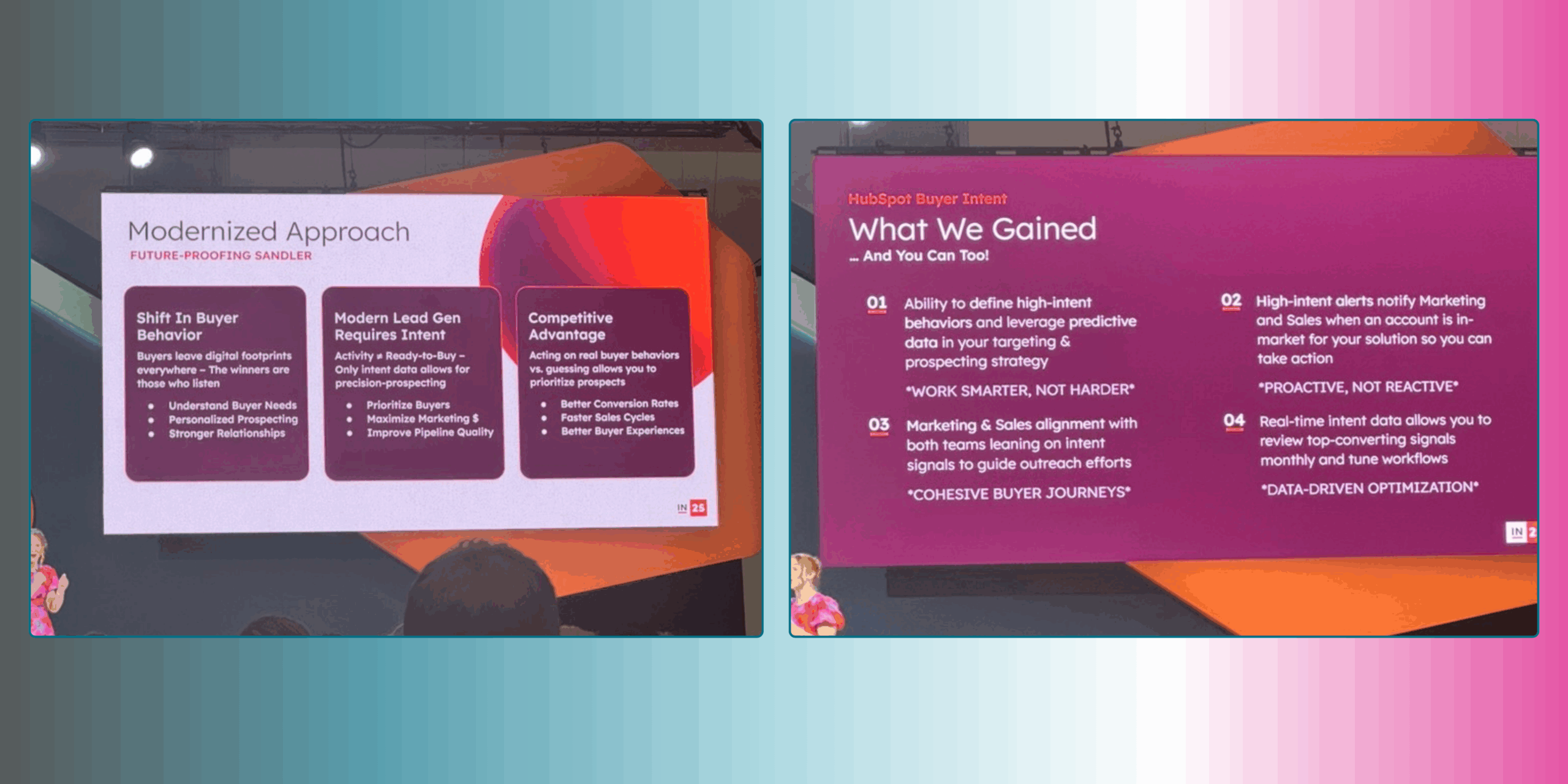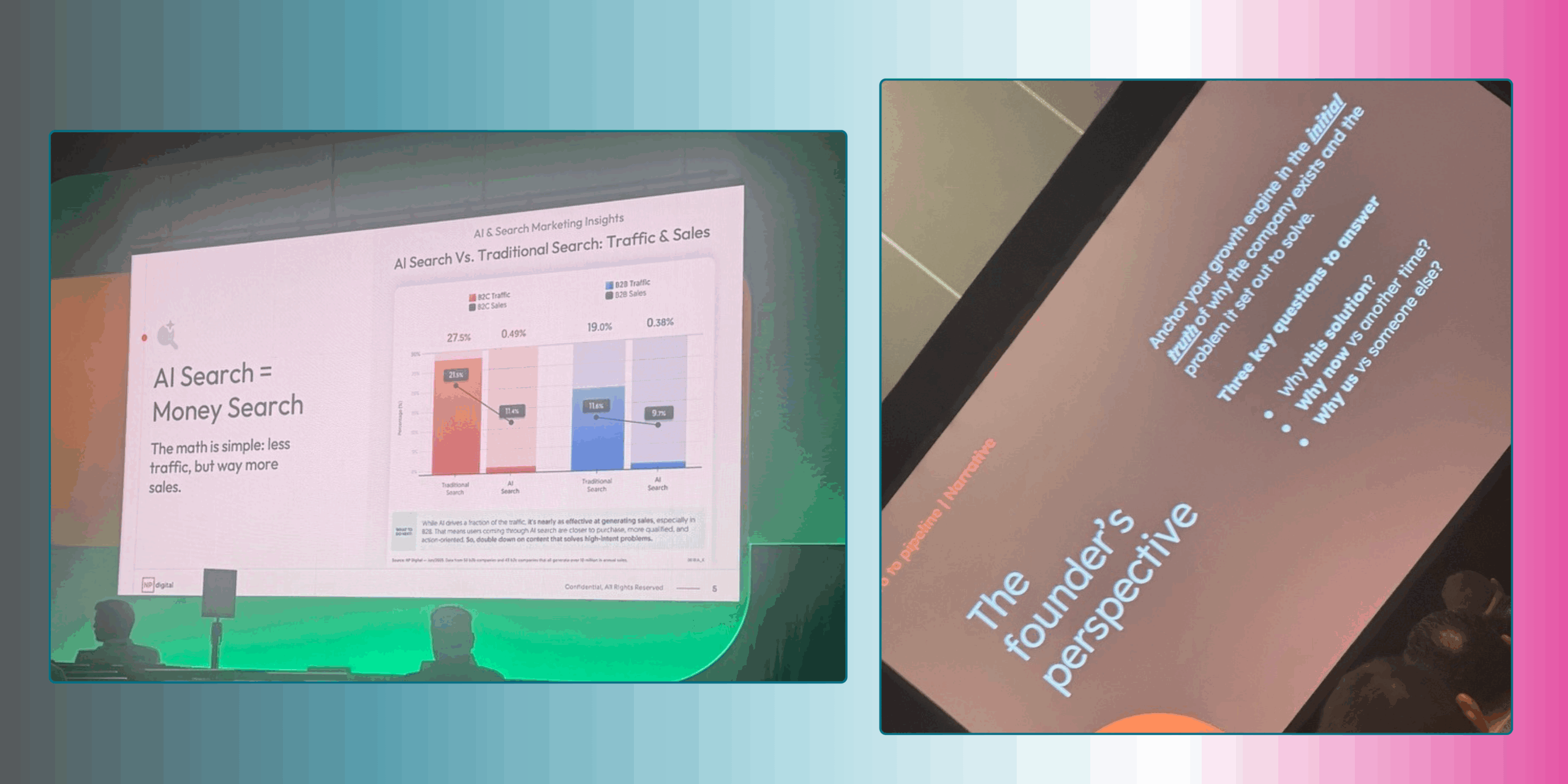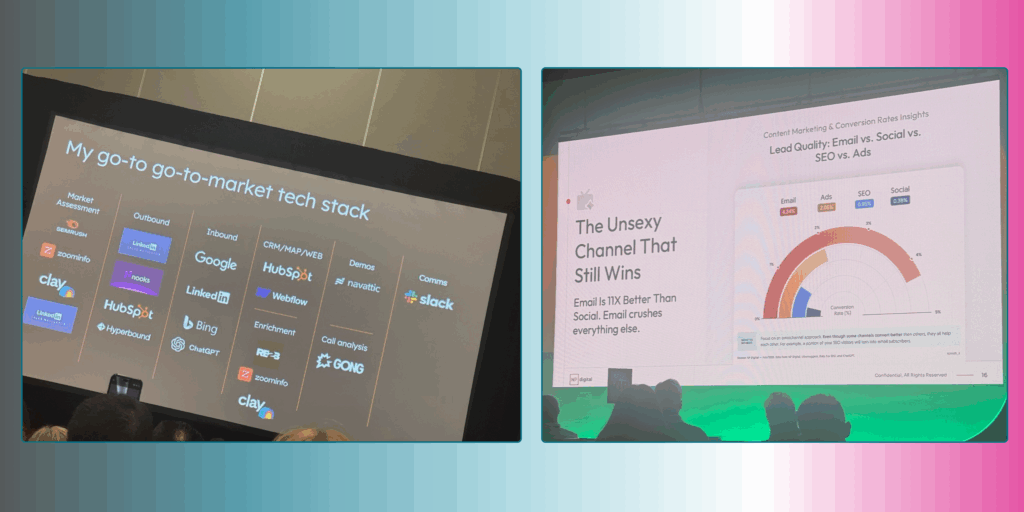If there was one unmissable theme at INBOUND this year, it was this: The GTM engine has evolved.
Sales development isn’t dead. Email isn’t dead. Even dialing isn’t dead.
But solo-channel tactics? Blind outreach? Top-of-funnel hustle with no mid- or bottom-funnel alignment?
Absolutely dead.
What we saw instead were high-performing revenue teams doing something very different:
– They’re sequencing smarter.
– They’re activating signals.
– And they’re finally building systems where marketing, sales, and product-led growth operate as a unified GTM motion.
If you want the TLDR version… here’s the 6 bold statements from INBOUND25!
- Do not optimize for the machine. Optimize for the human.
- iOS now stacks sender emails, driving a 49% lift in clicks on 90–180 day-old emails. This is why we see so much more activity on old emails!
- LLM-sourced leads convert 3x better due to higher intent, although traffic is significantly less. Quality > Quantity has finally hit the web analytics world too.
- PQLs (aka MQLs from product oriented marketing) convert 6x better than traditional MQLs, reaching 8–10% conversion rates to pipeline.
- Companies using 6+ channels see a 7.5% higher ROI across all channels.
- Nurturing pipeline pays. Deals with 40+ engagements deal momentum drives a ~70% win rate; below 10 drops to ~13% win rates.
Here’s our full breakdown of the most actionable, strategic takeaways from the event — and how modern teams are applying them to drive sustainable, scalable growth.

1. SDRs Are Back. But in a Whole New Lane
At one of the most buzzed-about sessions, a quote landed like a mic drop:
“If you’re responsible for sales development and you’re not enabled with a marketing engine that incorporates sales-ready tasks, you should quit right now.”
Brutal? Maybe.
Accurate? Absolutely.
The SDR role isn’t disappearing, it’s just finally entering the era of data and intent.
Here’s what the new SDR model looks like:
- Who they’re calling: High-fit ICP accounts enriched through platforms like Clay and ZoomInfo, and filtered based on meaningful engagement.
- Why they’re calling: Because the buyer already raised their hand, whether through pricing page visits, competitor comparisons, or demo video consumption.
- When they’re calling: Only after marketing sequences have built awareness and captured intent, never from scratch.
This isn’t about throwing bodies at outbound.
It’s about inserting skilled reps at exactly the right moment – when the data says “now.”
And it’s working: teams are seeing 20%+ connect rates when calls are properly sequenced after intent-triggering behavior.
2. PQLs Are Outperforming MQLs (By a Lot)
One of the most misunderstood, yet most promising, topics at INBOUND was the concept of Product-Qualified Leads (PQLs).
Let’s set the record straight:
A PQL is not a free trial user.
It’s an ideal-fit prospect who has had exposure to your solution before speaking to sales.
That exposure might include:
- Watching a demo video (especially a second view)
- Clicking through multiple product pages or interactive tours
- Engaging with onboarding-style content
And the payoff?
PQLs are converting at 6x the rate of traditional MQLs.
Why? Because the product (not just the pitch) is doing the heavy lifting upfront.
What does this mean for GTM teams?
- Show the product earlier in the funnel. Don’t save the demo for the first sales call, send it ahead of time.
- Use self-guided tours or personalized video walkthroughs (Loom, Consensus, AI-generated demos) to scale exposure without scaling headcount.
- Let the buyer build confidence in your solution before your first conversation.
We’re in an era of anti-social buying.
Buyers don’t want to talk to reps until they’ve already educated themselves.
So give them the tools to do just that…and meet them where they are.

3. What a Complete GTM Engine Looks Like in 2025
Several sessions converged around a unified truth:
Growth doesn’t come from more tools. It comes from tighter orchestration.
The companies winning right now are doing five things exceptionally well:
The Five Pillars of a Scalable GTM Engine:
- System: A clean, well-configured CRM and automation stack
- Narrative: Clear, differentiated market positioning that speaks to your ICP’s real pain
- Execution: Channel coordination across email, paid, outbound, product, and social
- Advocacy: Leveraging happy customers to drive referrals and trust
- Scale: Repeatable processes and metrics that evolve with the business
Marketing, sales, and RevOps leaders are no longer asking, “What tool should we add?”
They’re asking, “How do we make what we have work together?”
And the results are measurable. According to INBOUND data, companies using six or more GTM platforms in tandem see a 7.5% lift in ROI across all channels.

4. Four Non-Email Levers That Are (Quietly) Driving GTM Results
Email isn’t going anywhere. It’s still one of the highest-performing channels, with 11x better lead quality than social.
But it can’t do the job alone.
Here’s what’s coming back and delivering:
1. Live Events
Events are back, but not in the way they used to be. Booths don’t move pipeline, conversations do.
- Executive dinners and side events are outperforming big-budget activations
- Smaller formats = higher ROI
- A focused 30-minute conversation > 1,000 passive impressions
2. Call-Driven Outreach
When paired with intent and signals, calling works. Full stop.
- SDRs are being re-integrated into GTM plays but only with marketing alignment
- Enriched data + behavioral triggers = real conversations
- Teams are hitting 20%+ connect rates when calls are sequenced properly
3. Paid Media (With Discipline)
Paid is still the fastest lever but also the fastest way to burn cash.
- Focus on cost per meeting, not cost per lead
- Set ceilings, search volume always plateaus
- Diversify channels early, especially for niche ICPs
- Done right, paid search delivers the fastest closes and lowest cost per opportunity
4. Influencer and Social Plays
B2B influencer marketing is real and it’s shifting away from follower counts and toward relevance.
- Micro-influencers with 3K–10K engaged followers often outperform larger accounts
- Credibility > clout
- These voices are driving qualified awareness and trust at the top of the funnel
The Omnichannel GTM Model Is the New Standard
This year’s biggest insight wasn’t about a new platform or hack.
It was about alignment.
When marketing, sales, product, and RevOps operate as one GTM engine – with shared data, signals, and goals – results compound.
If you’re still relying on one or two disconnected channels, you’re leaving pipeline on the table.
The highest-growth teams are integrating:
- Email
- SDR calling
- Paid media
- Live events
- Product-led marketing
- Influencer and social content
And they’re tying it all back to a unified narrative and trackable revenue outcomes.
Final Word: The Engine Matters More Than the Activity
Anyone can send emails. Anyone can run paid ads.
But few teams have built a system where each motion fuels the next.
That’s what we help our clients build.
And that’s exactly what INBOUND 2025 reinforced.
Not every tactic works in isolation. But when they’re layered and aligned – when you stop guessing and start sequencing – the growth engine finally runs like it’s supposed to.
Ready to retool your GTM engine? Let’s talk about what’s next.
